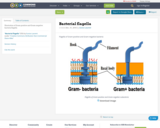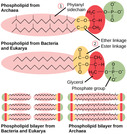
This illustration compares the cell walls of Gram-positive and Gram-negative bacteria
- Subject:
- Life Science
- Material Type:
- Diagram/Illustration
- Date Added:
- 12/31/2016

This illustration compares the cell walls of Gram-positive and Gram-negative bacteria

Illustration of Gram-positive and Gram-negative bacteria flagella

Biology is designed for multi-semester biology courses for science majors. It is grounded on an evolutionary basis and includes exciting features that highlight careers in the biological sciences and everyday applications of the concepts at hand. To meet the needs of today’s instructors and students, some content has been strategically condensed while maintaining the overall scope and coverage of traditional texts for this course. Instructors can customize the book, adapting it to the approach that works best in their classroom. Biology also includes an innovative art program that incorporates critical thinking and clicker questions to help students understand—and apply—key concepts.



By the end of this section, you will be able to:Describe the basic structure of a typical prokaryoteDescribe important differences in structure between Archaea and Bacteria

This resource is a video abstract of a research paper created by Research Square on behalf of its authors. It provides a synopsis that's easy to understand, and can be used to introduce the topics it covers to students, researchers, and the general public. The video's transcript is also provided in full, with a portion provided below for preview:
"The drug colistin is considered the “last resort” treatment for infections caused by multidrug-resistant Gram-negative bacteria. However, bacterial resistance to colistin is becoming increasingly prevalent, posing a public health threat. To help determine how to address this problem, researchers recently examined a highly colistin- resistant strain of Stenotrophomonas maltophilia. a Gram-negative opportunistic pathogen. The researchers identified a colistin-degrading protease (Cdp) in the strain and confirmed its role in resistance. In coculture experiments with the colistin-susceptible bacterium Pseudomonas aeruginosa, S. maltophilia inactivated colistin via Cdp and thereby protected P. aeruginosa from the antibiotic. This suggests that Cdp-mediated resistance might substantially limit colistin’s efficacy against polymicrobial infections, such as cystic fibrosis, even if some of the microbes present are sensitive to colistin..."
The rest of the transcript, along with a link to the research itself, is available on the resource itself.